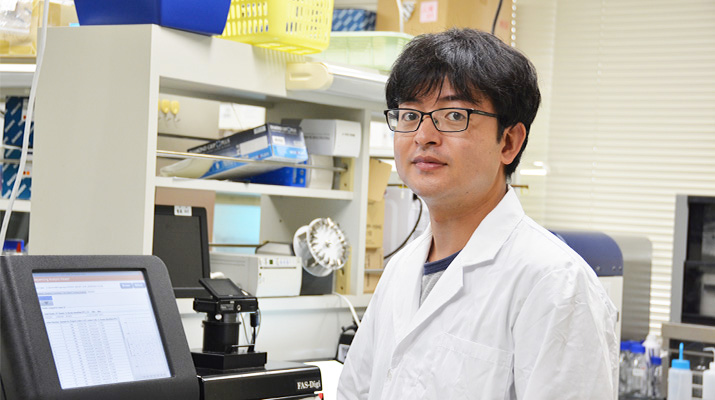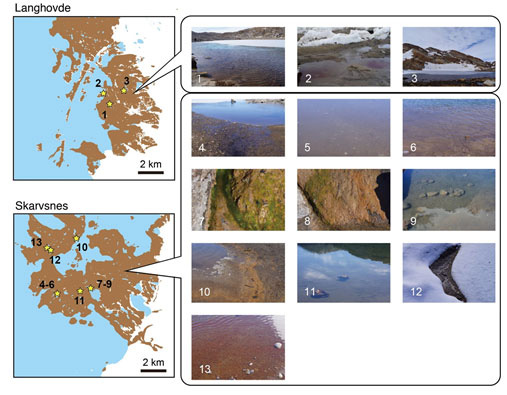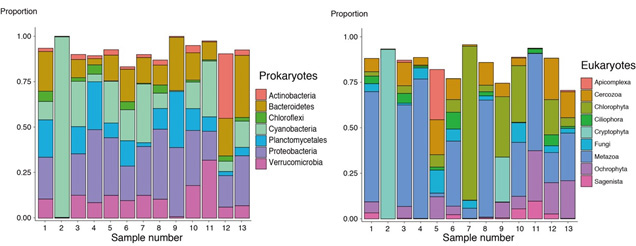
ここからコンテンツです。

Revealed the microbial community structures around Antarctic lakes
By Yuu Hirose
Prof. Yuu Hirose of the Department of Applied Chemistry and Life Science at Toyohashi University of Technology and his joint research group, comprising members from Niigata University, the Japan Agency for Marine-Earth Science and Technology (JAMSTEC), and the National Institute of Polar Research, have revealed the community structure of microorganisms living around freshwater lakes in the Langhovde and Skarvsnes ice-free areas of Antarctica. An analysis of samples collected from areas such as lake shores and puddles using a next-generation sequencer has verified that cyanobacteria and tardigrades are widely distributed and specific eukaryotic algae are dominant in certain sites. This knowledge will contribute to a better understanding of adaptation mechanisms of microorganisms to severe physical stresses in Antarctica, e.g. low temperatures, ultraviolet irradiation and freeze-thaw cycles.
Most of Antarctica is covered with thick snow and ice, but there are some ice-free areas, known as “Antarctic oases”, where the land is exposed. These ice-free areas occupy only about 0.2% of the area in Antarctica, but a variety of microorganisms have been observed. Two such areas, Langhovde and Skarvsnes, are close to Showa Station, Antarctica, and there are 50 or more lakes of various sizes in these areas (Fig. 1). Water at the bottom of these lakes remains unfrozen throughout the year and a unique ecosystem called “moss pillar,” that mainly includes moss and fungi, is distributed.
Assistant Prof. Yuu Hirose and others of the Department of Applied Chemistry and Life Science at Toyohashi University of Technology focused on the shores of freshwater lakes and also puddles and streams from snow meltwater. These environments are completely frozen during the winter season and accordingly are under more extreme stress (e.g. freezing and thawing and temperature changes), than those at the bottom of lakes.

In recent years, a technique for analyzing microbial community structure in environments using a next-generation sequencer has been developed. This method has a higher sensitivity and better quantitative properties than those of conventional techniques such as microscope observation. Assistant Prof. Hirose used this method to analyze microbial community structures at a total of 13 sites in the vicinity of Antarctic freshwater lakes (Fig. 2).
The results revealed that filamentous cyanobacteria were widely distributed, and also that the proportion of unicellular cyanobacteria and cyanobacteria with cell differentiation capacity (called heterocysts - cells dedicated to nitrogen fixation in filamentous cyanobacteria and formed mostly under nitrogen-deficient conditions) was small. The most widely distributed eukaryote was tardigrades with resistance to dryness and low temperatures. It was verified that specific eukaryotic algae such as cryptophyceae and green algae were dominant in some sites. There were also sites including nematodes feeding on algae. It is interesting that the fungi most dominant in moss pillars were not in the majority in these areas. The above results revealed that even in environments under extreme stress such as the borders of lakes or streams, a variety of organisms can survive.

It is expected that further study will be able to add greater clarity to the molecular mechanism that microorganisms living in these areas use to adapt to severe stresses. It is important to clarify the relationship between environmental factors, such as temperature and light conditions, and community structures of microorganisms. The monitoring and maintenance of the Antarctic ecosystem based on this information is also a valuable goal.
This work was supported by JSPS KAKENHI Grant Number JP15H05712, ""Plankton in polar regions -toward an understanding of their characteristics (representative: Naomi Harada)." The collection of samples was conducted as ordinary research observations of the 60th Japanese Antarctic Research Expedition.
Reference
Investigating Algal Communities in Lacustrine and Hydro-Terrestrial Environments of East Antarctica using Deep Amplicon Sequencing. Hirose, Y., Shiozaki, T., Otani, M., Kudoh, S., Imura S., Eki, T., Harada, N., Microorganisms 2020, 8(4), 497, doi.org/10.3390/microorganisms8040497
南極の湖沼周辺に生息する微生物の群集構造を解明
By 広瀬 侑豊橋技術科学大学 応用化学・生命工学系広瀬侑助教、新潟大学、海洋研究開発機構、国立極地研究所らの研究グループが、南極のラングホブデおよびスカルブスネス露岩域の湖沼周辺に生息する微生物の種類と組成(群集構造)を明らかにしました。湖沼の岸辺や水たまり等から採取した試料を次世代シークエンサーを用いて解析したところ、シアノバクテリアやクマムシが幅広く分布することや、特定の真核藻類の優占が確認されました。これらの知見は、南極大陸に生息する生物の有する低温・紫外線・凍結融解等のストレスへの適応機構の解明につながることが期待できます。
南極大陸のほとんどは厚い雪氷に覆われていますが、沿岸には陸地が露出した露岩域が存在します。露岩域は、南極大陸の面積の僅か0.2%程度ですが、微生物を中心とする多様な生物が確認され、南極のオアシスとも呼ばれています。南極の昭和基地の近辺には、ラングホブデ(Langhovde)とスカルブスネス(Skarvsnes)と呼ばれる2つの露岩域が存在し、これらの地域には大小50以上の湖沼が存在します(図1)。これらの湖沼の底は一年を通して水が凍らず、「コケ坊主」と呼ばれるコケや真菌などを中心とするユニークな生態システムが分布することが日本のグループによって発見され、研究が進められてきました。
豊橋技術科学大学応用化学・生命工学系の広瀬侑助教らは、海洋研究開発機構、新潟大学、国立極地研究所との共同研究により、コケ坊主が生息する湖沼の底よりも浅い水辺や、雪解け水によって生じた水たまりや小川に着目して堆積物の採取を行いました。これらの環境は、冬期には完全に凍ってしまうため、凍結融解や温度変化など、湖底よりも激しいストレスにさらされると考えられます。
近年、環境中の微生物の種類と組成(群集構造)を解析する手法として、次世代シークエンサーを用いて環境中に含まれるリボソームRNAの遺伝子配列を解析する手法が発展しています。この方法は、顕微鏡による観察や、生物の分離を含む手法よりも感度が高く、定量性に優れています。広瀬助教は今回、日本の研究グループとしては初めてこの解析手法を南極湖沼近辺の解析に取り入れ、合計13地点の微生物群集構造を解析しました(図2)。
その結果、細胞が数珠つなぎに連なった形態のシアノバクテリアが幅広く分布することが明らかとなりました。また、単細胞のシアノバクテリアや、ヘテロシスト と呼ばれる細胞分化能を持つシアノバクテリアの割合は少ないことが明らかとなりました。真核生物でもっとも幅広く分布していたのは、乾燥および低温耐性を有するクマムシでした。クリプト藻類や緑藻といった特定の真核藻類の優占が一部の地点で確認されました。藻類を食べるタイプの線虫が含まれる地点もありました。興味深いことに、「コケ坊主」でもっとも優先していた真菌類は、これらのエリアではあまり見られませんでした。以上の結果により、湖沼の浅い部分や、水たまりや小川といった厳しい環境条件でも、多様な生物が生息していることがわかりました。
今後は、これらの領域に生息する微生物が低温・紫外線・凍結といったストレスにどのように適応してきたのか、その分子機構の解明が期待されます。また、温度や光条件など、環境因子と微生物群集との関係の詳細を明らかにしていくことも重要です。これらの情報に基づいて、南極の生態系のモニタリングや保全を進めていくことも重要だと考えられます。
本研究は、JSPS科研費JP15H05712「極域プランクトン-その特質の理解―(代表者:原田尚美)」の助成を受けたものです。また、試料の採取は第60次南極地域観測隊の一般研究観測として実施されました。
Researcher Profile

| Name | Yuu Hirose |
|---|---|
| Affiliation | Department of Applied Chemistry and Life Science |
| Title | Assistant Professor |
| Fields of Research | Genome Biology, Photobiology |
ここでコンテンツ終わりです。
